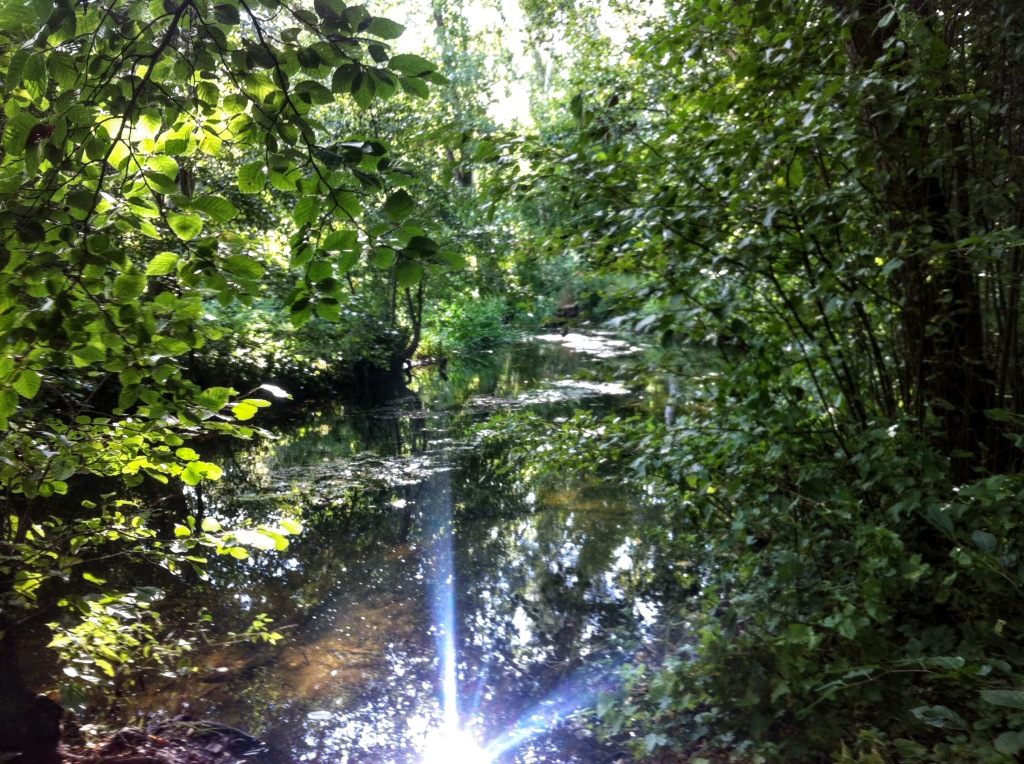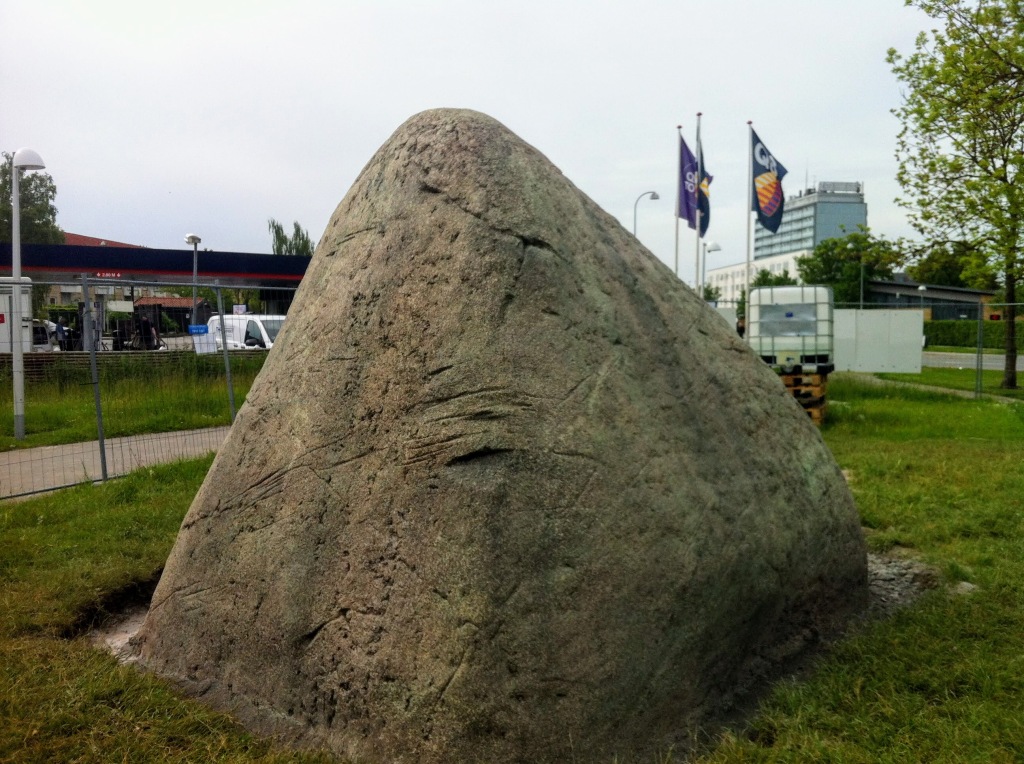After a couple of fallow years Vestegnens Kulturuge came good again in 2021 with the theme of Naturens steder – stedernes natur and a welcome focus on place and landscape.
The Danes’ relationship to nature tends to the anthropocentric, often with functional and utilitarian outcomes; this goes towards explaining the prevailing perception of Vestegnen as over-planned suburbia bisected by transport corridors and plagued by noise. In search of the authentic — and perhaps the unexpected — festival artist Camilla Berner discovered a more diverse picture, with nature in an ever-changing relationship with human development since the Ice Age. The infrastructure which dominates the landscape today is merely the most recent manifestation of this relationship.
Camilla’s art project, Flyttet Istid/Ice Age Relocated (vid), consisted of a sculpture in each of the five kommuner, supplemented by a kulturvandring (culture walk, often involving fællessang) and a lydvandring (sound walk; PodBean; vid) by Adda Djorup — all of this could have been made a tad more obvious in the festival publicity.
The sculptures took the form of large concrete rocks, resembling kæmpesten or vandreblokke (aka glacial erratics), situated in diverse spots in the landcape. Time for our fourth September roadtrip!
Albertslund’s rock lies in Egelundsparken in Store Vejleådal, a tunnel valley created during the Ice Age. Store Vejleå, the eponymous river/stream, can be spotted, as with Harrestrup Å a shadow of its former self, but the ‘nature end’ of Albertslund has much to offer.
The culture walk kicked off at the former state prison, followed by a 15 minute stroll to Egelundparken and a brace of artists’ talks. The sound walk follows the route to the sculpture from Roskildevej. During the festival the prison, now sold for redevelopment, also hosted Fængselsgourmet (FB): possibly the most Danish event ever, with fancy food and vibes.
Next up in geoglogical time, Høje-Taastrup. HT-the-kommune is massive (on Danish scale), and the rock is to be found in Hedehusene, a former industrial town (pop: 13K) near Roskilde, now reinventing itself as a residential hotspot for familien Danmark with the punnish new district of Nærheden. More precisely, the rock can be spotted beneath the viaduct over the overflow reservoir in Hedehusene Kulturpark, marking the area’s industrial heritage which exploited the sediment left by the retreat of the Ice Age.
The 4km culture walk (again) followed the same route as the sound walk, starting at Paul Gernes’ stone at Høje-Taastrup Gymnasium, taking in the memorial to resistance fighter Verner Emil Sørensen on the way to the park, seemingly bypassing the runestone at the church.
Onwards to Ishøj, where the rock can be found on the banks of Store Vejleå in a small wood, 2km north of the reclaimed land of Strandparken. The sea level here was once three metres higher than now, but today both the rock and the park feel well established. (Somewhat disappointingly, Ishøj’s etymology seems to stem from the Old Norsk word for yew, rather than from the Danish is (ice) + høj (high); although a local legend cites Isses høj as an option.)
As in Høje-Taastrup the culture walk and the sound walk followed the same route, wending its way from the library in Ishøj’s 1970s centre to the rock, before making a turn left towards Bredekærgård culture centre in the village of Tranegilde, crossing two major roads and the S tog line (twice) on the way.
The Vallensbæk rock can be found in Strandparken, sitting rather forlornly to the side of a small meadow just to the north of the marina, While still showing traces of its original 1970s landscaping (straight gravel paths and grass), the meadow, inaugurated (pics) as Vallensbæk’s culture walk, marks the final stretch of a climate change-friendly grønne strøg from the station, featuring a fakely winding path and designer lights.
Here the sound walk goes off piste, meandering along the paths between the low-roofed houses which characterise the første række along the full length of Strandparken and the water meadows which once formed the rather more malleable coastline.
Which brings us home to Hvidovre, at the urban end of suburbia. Beagle nr 3 and I first clocked the rock on 1 June, behind a fence awaiting its final touches. In a triangle of SLOAP next to Q8, where Friheden’s old chemist and a kro used to stand, it faces the roaring traffic of Gammel Køge Landevej and the graffiti on the S tog underpass, currently calling out capitalism. It’s a long way from the tunnel valley nearly 20 km to the northwest in Albertslund.
Both Hvidovre walks ignored this rather uncompromising location in favour of Kystagerparken, focusing on Strandøre, a disused dance pavilion from the 1930s, although the rock was inaugurated med manér with a vernissage attended by the mayor.
The Vestegnen rocks are for me the most successful of the festival’s pan-communal art projects. While Thomas Dambo’s giants have proved to be durable attractions, they could be anywhere (and are increasingly everywhere). The rocks have rather more layers, opening up the landscape around them and situating the man-made contours of Strandparken in a new context.
Rocks as placemaking? Random rocks are everywhere, once you start noticing them:
- as street furniture, to mark an entrance, eg to parking or a pedestrianised area, or a boundary, eg Kystagerparken
- as garden furniture, at the foot of your flagpole, or just lying in the drive
- as a memorial, often to the 1920 Genforening or 1945 Befrielesensdag, eg at every town hall
- or simply there in the landscape, eg Lodsparken
There was even further rock-related public art over the summer in the shape of Lea Guldditte Hestelund’s three sculptures for HUMMINGS in Køge, which “refer to the Danish tradition of using large natural stones from the sea as a roadblock or decoration in the public domain, a tradition that means that fish today lack breeding grounds”.
Also of note at this year’s festival was Unge Strunge tur/retur, theatre-on-the-move about Hvidovre’s very local ‘punk’ poet. Much more on this shortly. Posts on previous years: 2018; 2017; 2016.
Where is the Life we have lost in living? Where is the wisdom we have lost in knowledge? Where is the knowledge we have lost in information? (Choruses from The Rock, 1934)





Leave a comment